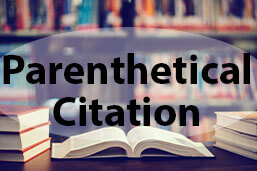
Parenthetical citations are a form of citing sources within the text, i.e., in-text citations. They generally include information that indicates where a source is taken from within a paper’s main text. There are different rules and several ways to use parenthetical citation depending on the context and Style Guide. Learn how to use parenthetical citations in the most commonly used academic writing styles such as MLA, APA style, and Chicago style below.
Definition: Parenthetical citation
A parenthetical citation attributes the source for a quote or paraphrased passage within the paper’s main body. It does so by providing source identification — the author’s name, year, and page number(s) — within parentheses (or brackets). This information corresponds to fuller bibliographical data which must be provided at the end of your paper.
Parenthetical citations are adopted by a wide number of academic writing styles across the sciences and humanities. MLA, APA style, and Chicago style all provide guidelines for using parenthetical citations. While the principles are mostly the same, each writing style has specific requirements to consider when composing a paper and formatting a citation.
Parenthetical citations in MLA
The MLA (or Modern Language Association) expresses its citations in an author-page format. This recommends that citations should contain the author’s last name followed by a page number or range separated by a space.
Page ranges are expressed with a dash and separate pages with a comma. No year is required, although some writers may prefer to include it in the prose itself if it helps their argument.
You can choose to include the citation in parentheses or cite it partially within the text itself (known as “in prose”). The parentheses always appear at the end of the sentence.
The convention for citing multiple authors is to only include up to two authors within the citation with an “and”.
For references written by more than two authors, include the first name followed by “et al.”.
Parenthetical citations in APA
The APA style (American Psychological Association) favors APA in-text citations. The APA style follows an author-year-page format with information appearing in that order.
All information should also be separated by commas rather than spaces. Pages are expressed with a “p.” for individual pages and “pp.” for page ranges.
You can include all citation information in parentheses or include some of it partially within the text (known as “narrative citation” in the APA style).
The conventions for narrative citation recommend that the author’s name appears within the text and the publication date with page numbers are included in parentheses.
With sources written by two authors, include both authors within the citation with a “&”. For citations by more than two authors, include an “et al.” after the first author.
Parenthetical citations in Chicago
The Chicago Style describes its use of parentheses as the author-date system. Chicago recommends this method for the sciences. Chicago follows an author-date-page order when making citations. The author and date should appear after a space only, while page numbers are separated by a comma.
As with other parenthetical styles, you don’t have to repeat the author’s name if it appears within the text itself. However, you should include the identifying year in parentheses and a page number where applicable. The citation should always appear at the end of the sentence.
Chicago recommends including up to three authors when naming a source, separated with an “and”. When there are more than three authors, simply include the first listed author followed by “et al.”.
FAQs
Parenthetical citations always appear enclosed in brackets at the end of a sentence.
The information included depends on the style, but often includes the author’s last name followed by either the year of publication and page number(s) or both.
MLA and APA both use parentheses to cite sources within the text. The Chicago style also allows the use of parentheses or notes and bibliography formats.
Not usually. You don’t have to repeat author information when it’s clear in the text.
If you’re quoting or paraphrasing a direct passage, yes. However, if you’re simply referencing a general book or idea, it may not be necessary.
